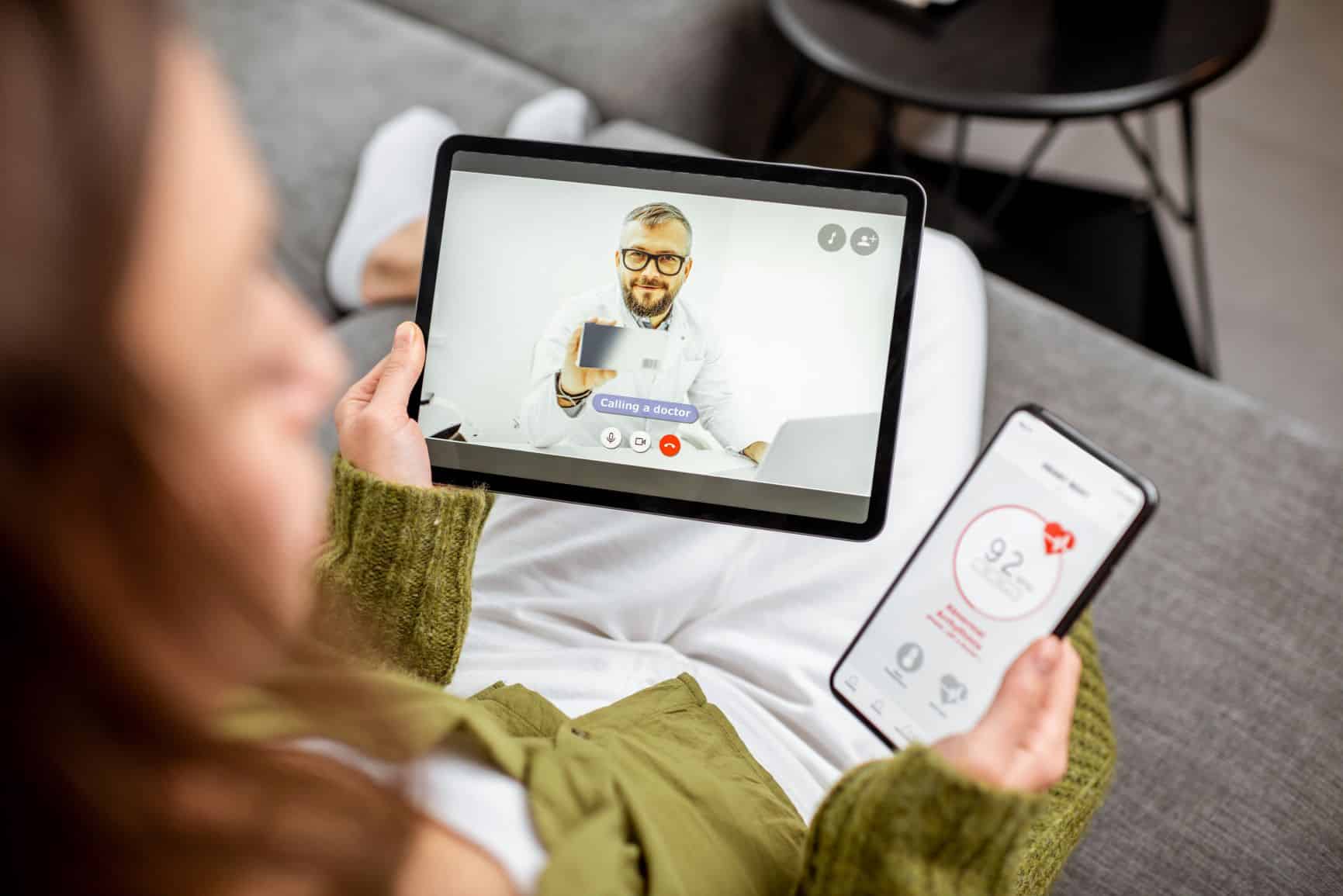COVID-19 accelerated the widespread use of telemedicine, but by all indications, telemedicine will be a trend that sticks around. As is the case for in-person visits, being proactive about how you prepare for an appointment can be the deciding factor in whether you have an efficient visit with a satisfying outcome, or a frustrating one.
We interviewed physicians and nurse practitioners who see telehealth patients to find out what patients can do to be a “star” patient. While each specialty and visit varies, the following is a list of considerations for patients as they prepare for their appointment to put them on track to being their provider’s best appointment of the day based on real-world examples from the doctors on the other side of your computer screen.
![]() Treat your appointment like an appointment: At the time of your appointment be in a quiet, private place with good cell or internet service. There might be a temptation to take a call from your car or knock out a chore while waiting for the appointment to start, but it’s important to set aside the time as you would for an in-person appointment. Your doctor knows when you’re in the grocery store– trust us, they told us it happens more than you’d think—and being distracted, rushed, unable to hear, or uncomfortable answering their questions in earshot of others, will prevent you from getting what you need.
Treat your appointment like an appointment: At the time of your appointment be in a quiet, private place with good cell or internet service. There might be a temptation to take a call from your car or knock out a chore while waiting for the appointment to start, but it’s important to set aside the time as you would for an in-person appointment. Your doctor knows when you’re in the grocery store– trust us, they told us it happens more than you’d think—and being distracted, rushed, unable to hear, or uncomfortable answering their questions in earshot of others, will prevent you from getting what you need.
![]() Test the software ahead of time: Anyone who has tried to plan a virtual happy hour in recent months knows that there is a seemingly 100% chance of technology giving you trouble right when you need it most. Be sure you have the necessary technology in place for your appointment, you have a good internet connection, and you know how to use the software. Test this far enough in advance that troubleshooting won’t cut into your appointment time.
Test the software ahead of time: Anyone who has tried to plan a virtual happy hour in recent months knows that there is a seemingly 100% chance of technology giving you trouble right when you need it most. Be sure you have the necessary technology in place for your appointment, you have a good internet connection, and you know how to use the software. Test this far enough in advance that troubleshooting won’t cut into your appointment time.
![]() Make sure the patient is present: It can be hard for kids to understand why they have to sit in one room while their siblings are playing upstairs, but providers would urge parents and caretakers to do their best to keep kids and others in their care present throughout the appointment. Spending minutes yelling down the hall or trying to get someone to answer a three-way phone call disrupts the appointment.
Make sure the patient is present: It can be hard for kids to understand why they have to sit in one room while their siblings are playing upstairs, but providers would urge parents and caretakers to do their best to keep kids and others in their care present throughout the appointment. Spending minutes yelling down the hall or trying to get someone to answer a three-way phone call disrupts the appointment.
![]() Have all medication names and dosages recorded or have pill bottles handy: It’s hard to remember the names and dosages of medications, but critical that a provider you’re speaking to have that information, especially if they are a specialist or this is your first visit. Write down your current prescriptions or better yet, have the pill bottles handy during your appointment to read off the label or let the provider read for themselves.
Have all medication names and dosages recorded or have pill bottles handy: It’s hard to remember the names and dosages of medications, but critical that a provider you’re speaking to have that information, especially if they are a specialist or this is your first visit. Write down your current prescriptions or better yet, have the pill bottles handy during your appointment to read off the label or let the provider read for themselves.
![]() Fill out intake forms and medical history thoroughly: Telehealth appointments can feel rushed by the time you get on the appointment, sort out audio levels, and lay out the reason for your visit. Filling out your intake forms and medical history thoroughly when sent to you before the appointment, ensures that your time with your healthcare professional is focused on you instead of your paperwork.
Fill out intake forms and medical history thoroughly: Telehealth appointments can feel rushed by the time you get on the appointment, sort out audio levels, and lay out the reason for your visit. Filling out your intake forms and medical history thoroughly when sent to you before the appointment, ensures that your time with your healthcare professional is focused on you instead of your paperwork.
![]() Check your weight, blood pressure, temperature, height, etc.: Not everyone has access to at-home medical devices, but there are some household items that can give you important health information. If possible, before your visit weigh yourself using your bathroom scale, take your temperature, check your kids’ heights against the wall, etc. Many fitness wearables and smart watches offer heart rate monitoring. Your Apple Watch may be the star of your next doctor’s appointment.
Check your weight, blood pressure, temperature, height, etc.: Not everyone has access to at-home medical devices, but there are some household items that can give you important health information. If possible, before your visit weigh yourself using your bathroom scale, take your temperature, check your kids’ heights against the wall, etc. Many fitness wearables and smart watches offer heart rate monitoring. Your Apple Watch may be the star of your next doctor’s appointment.
![]() Learn to properly use at-home medical devices: Many people have blood pressure cuffs, glucose meters, and other useful tools to get insights into their health at home. The information from these is only as good as it is accurate. Take the time to learn how to properly use these tools. Seek out help from your healthcare provider if you aren’t sure that you are doing it correctly.
Learn to properly use at-home medical devices: Many people have blood pressure cuffs, glucose meters, and other useful tools to get insights into their health at home. The information from these is only as good as it is accurate. Take the time to learn how to properly use these tools. Seek out help from your healthcare provider if you aren’t sure that you are doing it correctly.
![]() Know the reason for the visit: With a telehealth visit it is even more important than ever to go into the appointment knowing why you are there. Have all concerns written down and have a clear list of symptoms recorded. Getting right to the point saves time and makes it possible for the doctor to provide you with better answers and better service.
Know the reason for the visit: With a telehealth visit it is even more important than ever to go into the appointment knowing why you are there. Have all concerns written down and have a clear list of symptoms recorded. Getting right to the point saves time and makes it possible for the doctor to provide you with better answers and better service.
![]() Dress appropriately for the visit: We don’t mean business casual! Consider whether the doctor will need to be able to check a rash, view a swollen joint, or get a clear look at your face, and dress so it will be easy to accomplish that. Think about how long it would take to get a restless kindergartener out of multiple layers of clothes in the middle of winter and imagine trying to make that happen while trying to keep them focused on answering a doctor’s questions!
Dress appropriately for the visit: We don’t mean business casual! Consider whether the doctor will need to be able to check a rash, view a swollen joint, or get a clear look at your face, and dress so it will be easy to accomplish that. Think about how long it would take to get a restless kindergartener out of multiple layers of clothes in the middle of winter and imagine trying to make that happen while trying to keep them focused on answering a doctor’s questions!
Perhaps the most important piece of advice, however, is that golden rule of medicine: listen to your doctor. Their office will likely be sending out communications about whether you are a candidate for a telemedicine appointment, how to access the appointment, and what they would like you to have on hand for it. Then, all you have to do is check these boxes, and sit back and relax until your appointment begins. Just think of all the commute time you’re saving!




